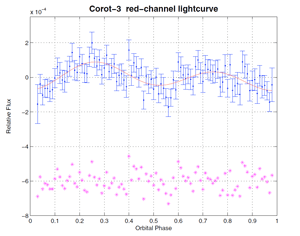Highlight: Detection of ellipsoidal and relativistic beaming effects in the CoRoT-3 lightcurve (vol. 521)
- Details
- Published on 19 October 2010
Detection of the ellipsoidal and relativistic beaming effects in the CoRoT-3 lightcurve

Close binary systems display three periodic photometric modulations: the ellipsoidal effect of the distortion of each component by the gravity of its companion, the reflection effect induced by the luminosity of each star only impinging on the close side of its companion, and the relativistic beaming effect induced by the stellar motion relative to the observer. Before space-based photometry, the last had only been observed once. Since then, it has been observed in two eclipsing binaries detected by the Kepler space mission. Mazeh & Faigler present the first detection of the combined ellispoidal and beaming effect in a system with a planetary/brown dwarf companion, CoRoT-3. The amplitude of the beaming effect is measured as only 27 +/- 9 ppm, highlighting the extreme photometric accuracy that can now be reached by space-based instruments.

